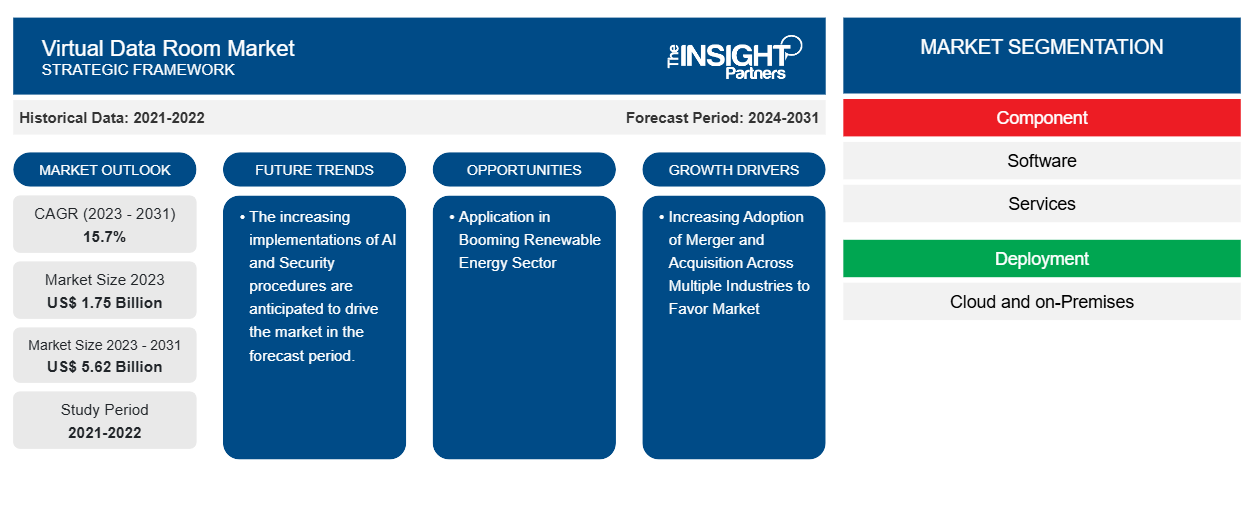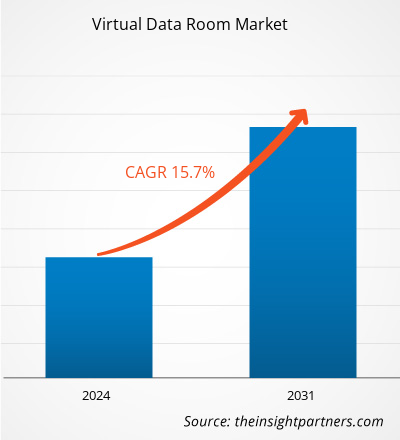The virtual data room market size is projected to reach US$ 5.62 billion by 2031 from US$ 1.75 billion in 2023. The market is expected to register a CAGR of 15.7% during 2023–2031. Increasing adoption of mergers and acquisitions across multiple industries and the development of advanced VDR technology for due diligence are likely to remain key trends and drivers in the market.
Virtual Data Room Market Analysis
The virtual data room market is experiencing significant growth globally. This growth is attributed to factors such as the increasing adoption of mergers and acquisitions across multiple industries and the development of advanced VDR technology for due diligence. Moreover, application in the blooming renewable energy sector and implementation of AI and security procedures are anticipated to hold several opportunities in the virtual data room market.
Virtual Data Room Market Overview
A virtual data room (VDR), also considered a deal room, is a secure online repository for document distribution and storage. It is characteristically utilized during the due diligence process, initiating a merger or acquisition to review, share, and disclose company documentation.
Customize This Report To Suit Your Requirement
You will get customization on any report - free of charge - including parts of this report, or country-level analysis, Excel Data pack, as well as avail great offers and discounts for start-ups & universities
Virtual Data Room Market: Strategic Insights

-
Get Top Key Market Trends of this report.This FREE sample will include data analysis, ranging from market trends to estimates and forecasts.
Virtual Data Room Market Drivers and Opportunities
Increasing Adoption of Merger and Acquisition Across Multiple Industries to Favor Market.
The increasing adoption of mergers and acquisitions across multiple industries is indeed driving the virtual data room market. VDRs are generally used by businesses when they are merging, running on a project, or any other joint venture that needs access to shared data. Moreover, various organizations are engaged in activities such as mergers and acquisitions. For instance, in June 2024, a company named Waste Management acquired Stericycle with a deal size of US$7.2 billion. Similarly, in June 2024, a company named Becton Dickinson acquired Edwards with a deal size of US$4.2 billion. Thus, considering the above parameters, the increasing adoption of mergers and acquisitions across multiple industries is indeed driving the virtual data room market.
Application in Booming Renewable Energy Sector.
Application in the booming renewable energy sector is anticipated to hold several opportunities for the virtual data room market in the coming years. The renewable energy sector is experiencing subtatial growth, promoted by innovative advancements and the worldwide shift toward sustainable energy sources. VDR is an essential tool that’s supporting this progress, a secure online platform for storing, managing, and sharing confidential documents. VDR holds several advantages, such as efficient project development, protecting intellectual property, navigating regulatory compliance, streamlining M&A activities, boosting financing and fundraising, optimizing asset management, and other. Thus, considering the above factors, the market is anticipated to hold several opportunities for virtual data rooms.
Virtual Data Room Market Report Segmentation Analysis
Key segments that contributed to the derivation of the virtual data room market analysis are component, deployment, organization size, business function, and end-user.
- Based on component, the virtual data room market is divided into software and services. The software segment is anticipated to hold a significant market share in the forecast period.
- Based on deployment, the virtual data room market is divided into on-premises and cloud. The on-premises segment is anticipated to hold a significant market share in the forecast period.
- By organization size, the market is segmented into SMEs and large enterprises. The SME segments are anticipated to hold a significant market share in the forecast period.
- Based on business function, the virtual data room market is divided into merger & acquisition, finance, marketing and sales, compliance and legal, workforce management, and others. The merger & acquisition segment is anticipated to hold a significant market share in the forecast period.
- By end-user, the market is segmented into BFSI, IT and telecommunication, healthcare, energy & power, retail, and others. The energy & power segments are anticipated to hold a significant market share in the forecast period.
Virtual Data Room Market Share Analysis by Geography
The geographic scope of the virtual data room market report is mainly divided into five regions: North America, Asia Pacific, Europe, Middle East & Africa, and South & Central America.
North America has dominated the virtual data room market. The North American virtual data market is segmented into US, Canada, and Mexico. The market is experiencing significant growth in the market driven by factors such as the increasing adoption of mergers and acquisitions across multiple industries and the development of advanced VDR technology for due diligence. Moreover, a strong emphasis on research and development in the developed economies of the US and Canada is forcing the North American players to bring technologically advanced solutions into the market. In addition, the US has a large number of virtual data room market players who have been increasingly focusing on developing innovative solutions. All these factors contribute to the region's growth of the virtual data room market.
Virtual Data Room Market Regional InsightsThe regional trends and factors influencing the Virtual Data Room Market throughout the forecast period have been thoroughly explained by the analysts at The Insight Partners. This section also discusses Virtual Data Room Market segments and geography across North America, Europe, Asia Pacific, Middle East and Africa, and South and Central America.
Virtual Data Room Market Report Scope
| Report Attribute | Details |
|---|---|
| Market size in 2023 | US$ 1.75 Billion |
| Market Size by 2031 | US$ 5.62 Billion |
| Global CAGR (2023 - 2031) | 15.7% |
| Historical Data | 2021-2022 |
| Forecast period | 2024-2031 |
| Segments Covered |
By Component
|
| Regions and Countries Covered |
North America
|
| Market leaders and key company profiles |
|
Virtual Data Room Market Players Density: Understanding Its Impact on Business Dynamics
The Virtual Data Room Market is growing rapidly, driven by increasing end-user demand due to factors such as evolving consumer preferences, technological advancements, and greater awareness of the product's benefits. As demand rises, businesses are expanding their offerings, innovating to meet consumer needs, and capitalizing on emerging trends, which further fuels market growth.

- Get the Virtual Data Room Market top key players overview
Virtual Data Room Market News and Recent Developments
The virtual data room market is evaluated by gathering qualitative and quantitative data post primary and secondary research, which includes important corporate publications, association data, and databases. A few of the developments in the virtual data room market are listed below:
- File-based collaborator Egnyte set up a secure virtual data room (VDR) service for sharing sensitive documents with third parties, with the idea of removing the need for MOVEit-like file transfer services. (Source: Egnyte, Company Website, October 2023)
- SentinelOne is amping up its offerings in India. The company announced the launch of a virtual data center in Mumbai that will enable the growing number of Indian companies that rely on SentinelOne to shield their business from cyber-attacks in a simple, compliant way. (Source: SentinelOne Company Website, July 2023)
Virtual Data Room Market Report Coverage and Deliverables
The “Virtual Data Room Market Size and Forecast (2021–2031)” report provides a detailed analysis of the market covering below areas:
- Virtual data room market size and forecast at global, regional, and country levels for all the key market segments covered under the scope
- Virtual data room market trends as well as market dynamics such as drivers, restraints, and key opportunities
- Detailed PEST/Porter’s Five Forces and SWOT analysis
- Virtual data room market analysis covering key market trends, global and regional framework, major players, regulations, and recent market developments
- Industry landscape and competition analysis covering market concentration, heat map analysis, prominent players, and recent developments for the virtual data room market
- Detailed company profiles
Frequently Asked Questions
What would be the estimated value of the virtual data room market by 2031?
Which are the leading players operating in the virtual data room market?
What are the future trends of the virtual data room market?
What are the driving factors impacting the virtual data room market?
Which region dominated the virtual data room market in 2023?
What is the expected CAGR of the virtual data room market?
- Historical Analysis (2 Years), Base Year, Forecast (7 Years) with CAGR
- PEST and SWOT Analysis
- Market Size Value / Volume - Global, Regional, Country
- Industry and Competitive Landscape
- Excel Dataset
Recent Reports
Related Reports
Testimonials
Reason to Buy
- Informed Decision-Making
- Understanding Market Dynamics
- Competitive Analysis
- Identifying Emerging Markets
- Customer Insights
- Market Forecasts
- Risk Mitigation
- Boosting Operational Efficiency
- Strategic Planning
- Investment Justification
- Tracking Industry Innovations
- Aligning with Regulatory Trends





















 Get Free Sample For
Get Free Sample For